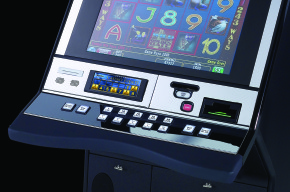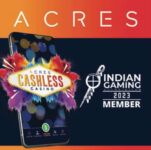
It seems hard to believe in 2008, but there was a time when non-tribal casino operators were reluctant to use TITO (ticket-in/ticket out systems) for their slot machines.
Why? They assumed-incorrectly, as it turned out-that one of the most entertaining aspects of gambling for players was playing with cold, hard cash.
“Operators thought patrons wanted to hear the coins drop. They thought they’d always want rolls of quarters. They thought they’d always want to insert cash,” says Knute Knudson, vice president for Native American development for International Gaming Technology, the leading supplier of gaming machines and monitoring systems in the world.
“But Indian Country was way ahead of traditional markets. There were a few holdouts, but everybody got over it, and TITO revolutionized the casino industry.”
Today, it’s next-to-impossible to find cash-based systems on the casino floor, and the operational benefits have been immeasurable. Without coin-handling equipment (which were notoriously prone to jams that held up play), casino costs have been cut as much as 40 percent. No more hand-pays means no more frustrated players, forced to suspend their games during a tedious count.
Coin-handling by staff-an arduous and downright dirty task-has also been eliminated, along with vaults, coin carts, and security personnel. TITO also made multi-denomination gaming machines possible.
Of course, it goes without saying that overflowing counting rooms, like the one immortalized in the Martin Scorsese film Casino, posed a security risk like no other. Thanks to cashless environments, that risk has now been eliminated.
Pioneering for its time, TITO was just one of several groundbreaking innovations- in back-end technology, customer service and casino games themselves-that originated in Native American casinos, then took hold in the industry at large. They include nothing less than the innovations that could soon make server-based gaming an industry standard.
Indian Country First
At first, tribal casinos were driven to technical innovation so they could offer an approximation of Vegas-style slots while adhering to Class II regulations. Their devices looked and played like slot machines-a great lure for the gambling public-but under the hood, they were really electronic bingo drawings or pull-tab games.
Few could have predicted in the 1990s that some Class II games would become the models for today’s Class III game designers. It’s due in part to the fact that many Class III games were developed and became entrenched before the technological explosion that made personal computers, internet and lightning-fast communications facts of daily life.
“Compared to where casino technology is today, yes, Class II is ahead of the curve, because most of it was developed after the turn of the century,” says Aaron Rubin, director of marketing for Video Gaming Technologies, provider of games for Class II and emerging markets. “The prototypes are faster, and just from a raw technical standpoint, we’re ahead.”
Rubin says older-generation Class III games will probably stick around a while because they’re “like the car you’ve already bought and paid for. You own it. It runs. And it’s nice not having car payments.”
But as casino games advance in complexity, speed and entertainment value, he says, those older games-just like that battered old family Buick-may have to be replaced. If games don’t remain competitive-with increased bells and whistles, dazzling 3-D graphics, digital-quality sound and superior hit ratios-they just may become an operator’s loss leaders, and even brand a host casino as behind the times.
It was necessity that made Class II game makers the industry’s mothers of invention, suggests Terry Daly, who is vice president of game systems for Rocket Gaming, which supplies Class II entertainment software and electronic players stations to casinos in 11 states.
“From a designer’s standpoint, from a game standpoint, we needed to create games that kept players interested and on the floor,” Daly says. “We developed a wide variety of entertainment-type games along with more of a gambler-type game and then a cross-section that appeals to both”-all with enough amusement value and chances to win to keep players playing.
“Gambling-type games have pure map models; you don’t win very often but you when you do, you can win big,” Daly says. “Other games are more entertainment-based, where you can play for a long time and enjoy the bonus features.” He described the company’s newest games as “entertaining and feature-heavy.
“We are right in the process of rolling out a series called Jackpot Jubilee (an umbrella for a number of different titles including One Bad Apple, Whopper and Great White Diamond). Each has its own map model and separate bonus features, but they share a common jackpot, plus there are features that take players into a secondary game that allows them the opportunity to win up to four different progressive jackpots.”
Frequent jackpots are a winning concept, says Rubin.
“Unlike at a slot machine, where you pull (the handle) a bunch of times and may never win, Class II always wins.” He adds that more social and interactive play-a fundamental tenet of Class II play-is becoming increasingly popular in non-tribal houses.
“Instead of you playing against the slot machine, you play against other players for a progressive prize. It makes for a lot more interactivity,” says Rubin.
A case in point: IGT’s Wheel of Fortune arena game, with multiple participants at adjacent terminals around a common wheel. It’s become one of the most popular slot machine games in the country.
Server First
Central determination, also referred to as downloadable technology or server-based gaming, may prove the greatest contribution from Indian Country to the mainstream gaming hall.
Born in 1995 with systems developed for California’s Pala tribe, it is now viewed as the next wave in slots technology, with manufacturers investing millions per year in research and development of Class III applications.
“Server-based technology makes a very compelling story, not just for the player, but for the operator,” says Kunal Mishra, vice president of product management and marketing for Atlanta-based Cadillac Jack, a provider of high-speed, interactive electronic games and systems to the global gaming industry.
“By definition, it got its start in Class II gaming because a server always had to be attached to a game to provide the download of content to the machine. Beyond that, it added the technological basis for operators to make instant business decisions to increase the profitability of their floor.”
With server-based gaming, tribal casinos could quickly switch game titles from a remote command center, and offer more and broader community gaming (a prerequisite for bingo, in which players compete for a communally-generated pot).
In time, as systems became more sophisticated and servers made by different manufacturers began to communicate through back-end systems, tickets could be played from one maker’s game to another. All these efficiencies in tribal gaming boosted the revenue-generating power of the casino; the value of every square foot of gaming space could be maximized.
The technology is expected to become ubiquitous across the industry. By 2005, nearly every major slot machine manufacturer brought server-based slot machines to the Global Gaming Expo in Las Vegas, and by 2006, those games were getting trials in California and Nevada.
Server-based gaming also enables operators to tailor games to player preference. Casinos are growing more interested in electronic data warehouses and analytical computer software to track who’s playing and when; in conjunction with server-based capabilities, which can alter the floor set-up and game availabilities with the click of a mouse, casinos can change from penny games to nickel games at will-all from a remote “mother ship.”
In the case of Rocket Gaming, the central base, which powers 4,000 machines, is in Oklahoma.
“The technology throughout the industry is not quite there yet, but certainly server-based gaming is a lot easier,” says Rocket’s Terry Daly. “You can change the game or denomination from a central server point at any location, rather than going out and making a physical change (at the casino); we also have the ability to maintain security. Our checks and balances make sure that everything is as it’s supposed to be, and there are several backup systems in place” so there is no possibility of a crash.
“From a service standpoint, server-based technology allows you not only to download content and change features, it also allows you to identify problems before they actually hit and have an impact on the casino.”
Analysts say server-based gaming could have the same effect on the slot machine floor as TITO, which since 2002 has sent operators scurrying (and spending millions) to replace games.
Advances in technology have also made heavyweight players of tech manufacturers. Thanks to ticket in-ticket out, for example, the stock price at International Game Technology rose more than 570 percent between 2000, when the technology first emerged, and the end of 2004.
Standing Still
Despite the increasing interest in central determination or server-based systems, few foresee the end of stand-alone casino games.
“Some people would like to think that stand-alones will be phased out,” says Bruce Rowe, senior vice president for business development for Vegas-based Bally Technologies, a leading supplier of gaming machines and technology products. “What we’re really starting to see is a migration to bidirectional networks; it’s our belief that there will be an evolution over the next several years towards a robust bidirectional networking capability.”
Such a direction will benefit the industry in a couple of ways, Rowe says:
“One, it will improve the integrity of the games by being able to (easily) hold them, interrogate them and download software. Two, it will improve marketing at the point of play so operators can do marketing and loyalty to the customer before or after their gaming session. Three, it will offer second ways to win for the customer through promotions and bonusing games.
“Those are three of the key ones, as well as improved service at the game-a ‘concierge-in-a-box’ kind of idea that also provides drink and valet services, calls for your car in advance, that sort of thing. There are other ideas for being able to configure games so you have the ideal mix by time of day and day of the week. Otherwise, it’s like having a restaurant and never being able to change the menu from breakfast to lunch to dinner.”
Borrowing Success
Sometimes, says Rowe, technologies first borrowed by the Indians from mainstream environments were improved on the Class II casino floor.
“In the early stages, tribal operations inherited the best-of-breed technology from traditional Class III environments. But as time went on, those tribes-who many times at opening were new to the gaming industry, and had limited financial backing-started to become more knowledgeable and more independent financially.”
Mostly self-governed, “they developed oversight bodies that were often more nimble in making decisions about technology than the large corporations that got them started,” Rowe says. Faced with greater competitive challenges but blessed with more independence and less bureaucracy, the tribes looked for new and better ways to run their operations-and they found them.
“As the market started to mature, so did the sophistication of the operations, the availability of cash to put back into technology and innovations, and the speed with which technology could be experimented with and deployed,” says Rowe.
In the ongoing saga of mainstream and tribal gaming, in many ways the follower has become the leader, and Native American casinos are setting the standards for tomorrow’s gaming industry.


















